Menu
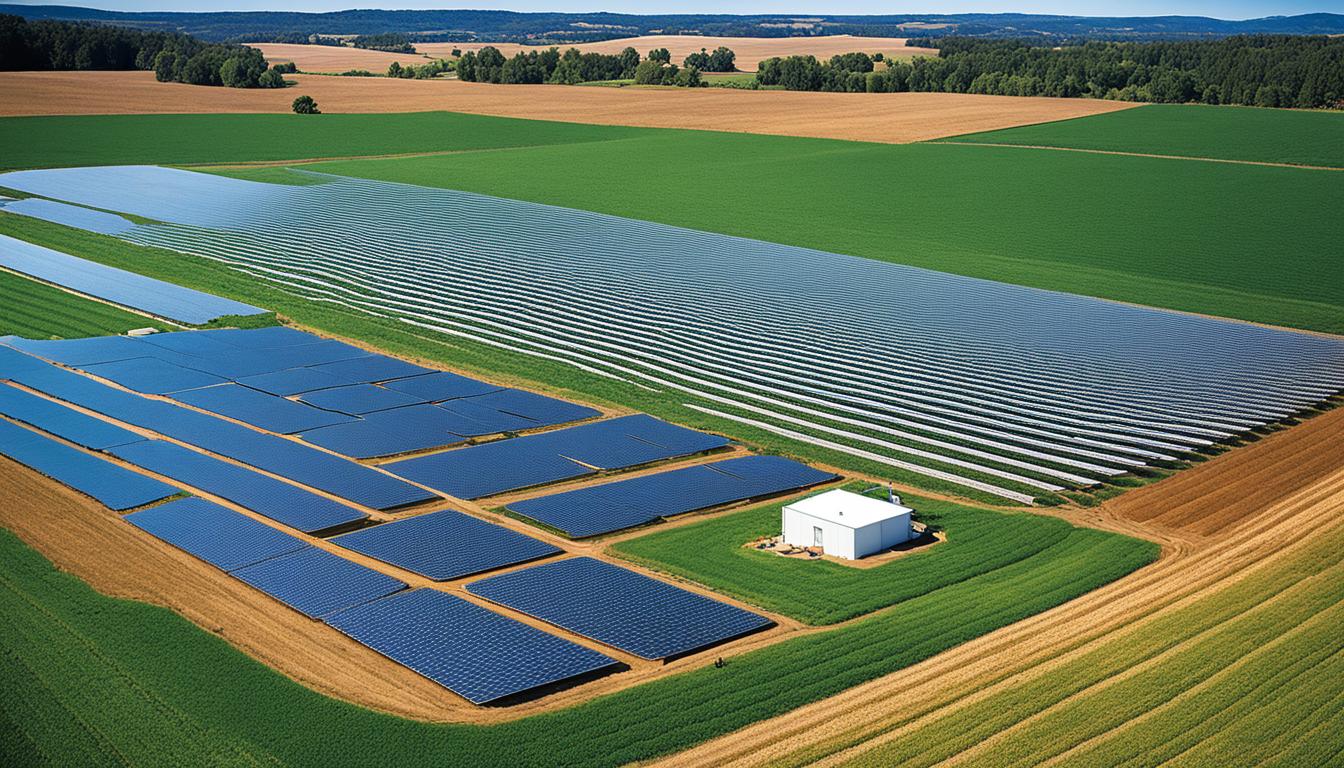
Did you know nearly half of farmers markets now sell organic products? Many more offer chemical or pesticide-free items. This big change shows a move towards sustainable farming. People both buying and selling food know it’s important to care for the planet. For small farms, following new environmental rules is crucial for their success. This means choosing sustainable methods, getting organic certificates, and looking after biodiversity.
Small farms can pick eco-friendly ways that also fit their goals. They can save nature by working with the Natural Resources Conservation Service (NRCS). Together, they plan ways to save water, prevent pollution, and keep soil healthy. Getting organic certifications makes it easier to sell products. And looking after the variety of life on a farm helps the environment and makes the farm more successful.
Today, sustainable agriculture practices are a must for small farms. They must follow strict environmental protection guidelines. These rules help protect nature and make sure farming is done in a way that lasts. From what I’ve seen, the rules for small farms environmental standards keep getting more detailed. They aim to save natural resources and grow food in the best way.
NRCS gives farmers the help they need to meet these standards. They share their knowledge and tools. This support is crucial for farms to meet the rules on the environment.
If you’re a farmer who wants to be green, NRCS has info that can help. They offer guides on things like how buildings should be made and the difference between streams and ditches. One big thing farmers need to understand is a rule change about tile drains from 2018.
There’s also a test called the RAP Quiz that takes about an hour. Passing it gives you two points towards water cleanliness. This quiz is part of a larger plan. Every five years, farmers must do a four-hour course on water quality. They need these points to stay certified as good, green farms.
Big farms that have lots of animals, like 300 cows or more, need special permission to operate. Notifying the USDA and NRCS about how your farm affects the land is needed if you join certain USDA programs.
When it comes to using bug killers, New York says the person spraying must be over 17 and trained. They should keep learning every five years. This includes earning certain credits in different areas of farming.
| Requirement | Details |
|---|---|
| Certification Period | 5 Years |
| Educational Credits | 25% Category-specific training |
| Annual Compliance Certification | Mandatory for RAPs |
| CAFO Permit | 300+ mature dairy cows |
| Filing Form AD-1026 | HELC/WC Activity Notification |
Following these environmental protection guidelines is key. It keeps farms green and legal. NRCS’s help is vital for meeting these small farms environmental standards.
Conservation planning is vital for sustainable farming on small plots. With help from NRCS, landowners can manage resources wisely. This improves ecological balance. The process is carefully planned, focusing on the farm’s specific needs.
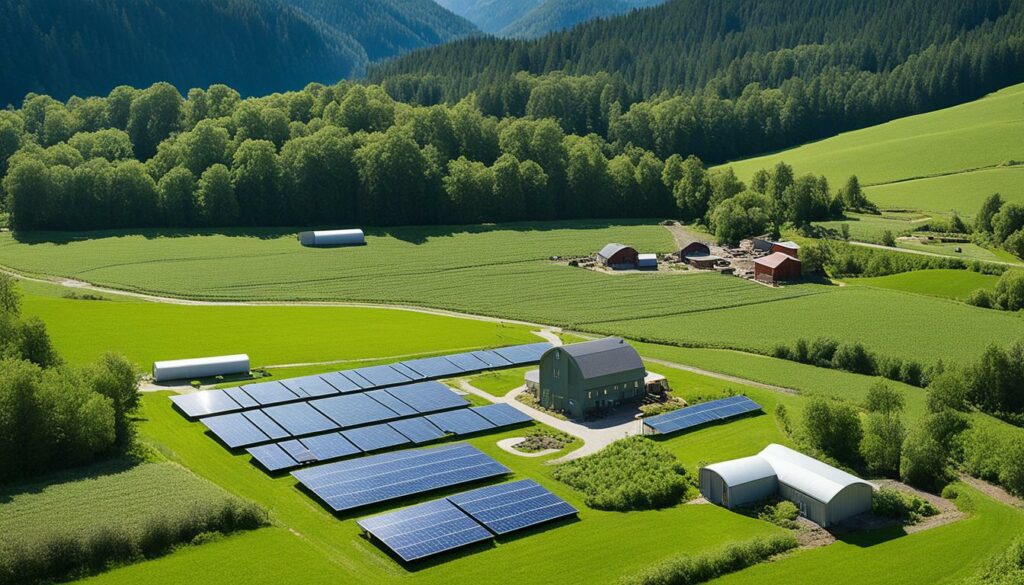
The NRCS follows a nine-step plan to support farmers. It starts by looking at problems and good chances. Then, it sets goals, checks what resources are available, and studies the data. Next comes making and checking different plans, choosing the best options, turning ideas into action, and then reviewing the results.
NRCS technical services include tools like land maps, soil details, and economic studies. These help farmers make smart choices. Planners work closely with farmers. They make sure the plans are clear, doable, and right for each farm.
One major part of doing plans well is making them fit each farm. As things come up, goals might change. Knowing what resources are there helps spot issues. It also helps find the best options for solving them.
NRCS makes sure farmers have a big say in picking what to do. Plans aren’t set in stone. They need regular checks to stay effective over time. With help from NRCS technical services, farmers can build farms that do well both for them and nature.
By 2050, nearly 10 billion people will need 70% more food. Sustainable agriculture is vital. It offers more food with better quality. This helps save the soil and supports small farmers.
Planting cover crops like rye and clover is key. They stop weeds, slow soil loss, and add nutrients. These practices lead to higher-quality food. They also help with certification for organic farming.
Cover crops make our food system stronger. They protect against bad weather and price changes.
Composting manure is crucial for the earth. It makes the soil healthier and reduces bad fertilisers. This move is good for the soils and cuts costs for farmers. It is also in line with organic farming values.
Composting means farms can make premium, organic products. This helps and protects the environment.
Dealing with pests naturally is better for everyone. It uses natural enemies and strong plants to beat pests. These ways support stable and healthy farming. They are also important for getting organic certifications.
This type of farming is good for our planet. It leads to long-term success in feeding everyone.
“Sustainable agriculture can create stronger local economies and economic opportunities for small-scale farmers, resulting in producing more food with fewer resources and fewer expenses.”
Choosing sustainable and natural farming is key for small farms. It helps them do well in the future. These methods support a fair and strong food system.
Adding eco-friendly farming methods to small farms is crucial. It helps meet new green rules and makes the farm stronger. We will look closer at two top eco steps linked to environmental protection guidelines and sustainable agriculture practices.
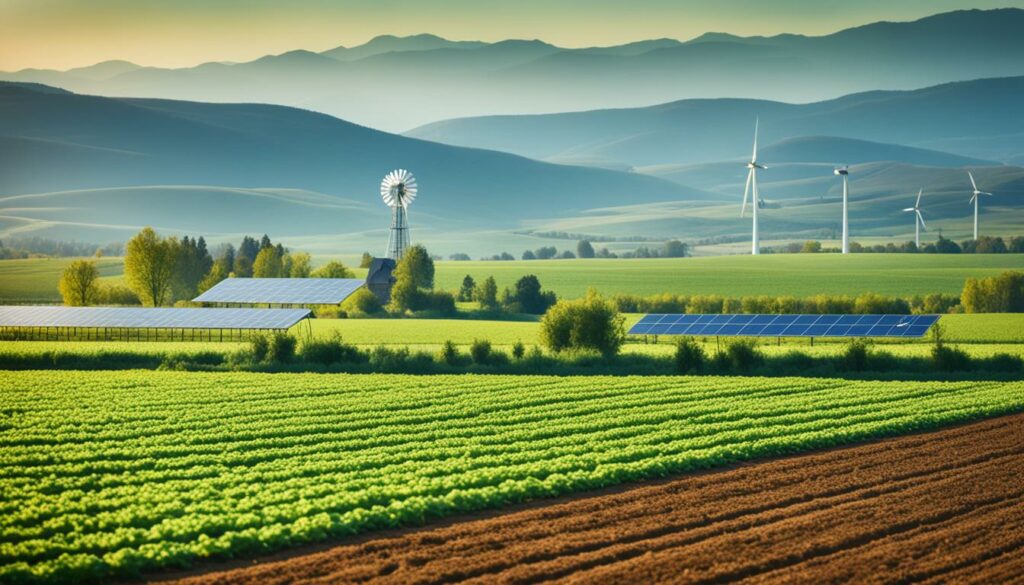
Windbreaks act like shields against tough weather, keeping soil wet and crops safe. By planting rows of trees or bushes just right, you can lessen wind wear and keep a good air and heat for plants. This approach brings big and varied advantages:
With farming employing more than a billion around the world and earning $1.3 trillion yearly, moving to methods like windbreaks is key. It means our farming can last longer even in tough times.
Grassed waterways are impactful for the environment. They are channels covered in long-lasting grass, which handle rainwater on fields well. This is how they make a difference:
As half of the world’s land is used for growing food, using these methods is vital. They help keep soil and water in good shape for the future. Plus, these ways of farming cut down how much we plough the land, lowering carbon by as much as taking 12.4 million cars off the road. This matches perfectly with environmental protection guidelines.
“By using grassed waterways, we care for our soil and create a great place for local plants and animals to grow. This shows how using eco ways of farming is good for everyone.” — Jane Doe, Sustainable Agriculture Expert
| Farming Method | Benefit | Impact on Farm |
|---|---|---|
| Windbreaks | Reduces wind erosion | Improves crop-yield and soil moisture retention |
| Grassed Waterways | Controls runoff and erosion | Sustains soil quality and promotes biodiversity |
By picking up sustainable agriculture practices, farmers build more solid, fruitful, and earth-caring farms. This ensures farming can keep going well into the future, meeting green rules head on.
Small farms face big challenges due to water scarcity. Using efficient irrigation methods like gravity-fed systems is key. These methods help save water and keep farms going. By 2040, farms in the San Joaquin Valley might have 20% less water. This would affect about 900,000 acres of farms. Managing water better is critical because of this.
Good irrigation systems are vital for farm water use. Gravity-fed systems are good because they match what crops need and the weather. Smaller farms, under 50 acres, get about 2.2 acre-feet of water per acre. But, bigger farms get less water, which shows why smart irrigation is so important.
For small farms without much surface water, cheap irrigation is a must. Around 20% of these farms use groundwater. These systems can cut water use by half, helping deal with water scarcity without big costs.
Using springs for water can be a good solution for farms in some areas. This is especially true where there’s not much groundwater. Small farms need lots of water for their crops. Spring water can meet these needs and help small farms keep running.
Managing waste on farms well is key for the planet and farm success. It lets farmers turn waste into things that make the soil better and help create energy.

Turning farm waste into compost is a smart way to reuse nutrients. It makes the soil richer and helps it hold water better. This way, farms can be healthy without needing chemical fertilizers. It’s a green win-win.
Biogas systems are getting more popular because they cut waste and create energy. They turn organic waste into gas for heating or making electricity. Many countries and regions support this, seeing it as a great way to manage waste wisely.
Putting crop leftovers on the ground as mulch is a great idea. It keeps moisture in the soil, stops weeds, and makes the soil better. There are even ways to turn these leftover crops into things like biofuel. This is good for both the soil and the planet.
Farmers who use these methods help the environment and run their farms well. By changing waste into useful things, they are at the forefront of green farming.
For small farms looking to meet high environmental standards, getting organic farming certification is key. This certifies that you’re following sustainable agriculture practices. Even if the process can cost a fair bit, you may get up to 75% back from the USDA.
Becoming organic isn’t just a simple change. It takes three years of avoiding certain substances. During this time, you can’t call your products “organic” or include the USDA seal. To help with this change, the USDA’s EQIP provides support.
For small farms, joining a group to get certified is smart. It cuts costs per acre versus going it alone. Plus, it means lower transport costs and helps keep your supply quality steady.
If you’re after a cost-effective way to sell locally, check out PGS. It lets you label and sell as organic right in your local market. IFOAM and others are there to help, offering guidance and open markets. Group certification not only means the quality stays high but also builds strong farmer communities.
Getting organic farming certification brings together sustainable agriculture practices and eco-friendly farming methods. It helps the environment and your farm’s economy.
| Benefit | Explanation |
|---|---|
| Cost Reimbursement | USDA programs cover up to 75% of certification costs |
| Group Certification | Reduces individual costs and enhances market consistency |
| Technical & Financial Assistance | Provided through EQIP during transition period |
| Market Access | PGS and IFOAM support for labelling and global market entry |
| Quality Assurance | Ensured through consistent standards and communal practices |
Maintaining soil health is key for small farms to be productive over time. Farmers mix strategies to keep their soil rich and strong against problems like erosion. These steps help a lot in farming sustainably.

Testing the soil regularly is a crucial first step. This process lets farmers know what nutrients the soil lacks, so they can add them. It’s a smart way to manage soil fertility and decide on the right fertilisers.
Rotating crops has long been a way to boost the soil’s health. It helps stop erosion and breaks pest cycles, which is good for both soil and crops. Adding legumes to the mix can enhance nitrogen levels and boost fertility.
Taking care of natural plants is also key to soil health. They keep nutrients moving and help control water. These plants also protect the soil, support wildlife, and prevent erosion. It’s a vital part of farming sustainably.
By using these tactics, small farms can improve their soil health. This leads to better fertility management and more sustainable farming. In the end, these efforts help farms succeed over the long term.
Adding biodiversity conservation methods on small farms helps build strong ecosystems. Farmers boost environmental health by encouraging a variety of plants and animals. This way, their farms work better and last longer.
Planting areas for native pollinators, like bees and butterflies, is vital. They help crops grow better through pollination, leading to more produce. I ensure they thrive on my farm by growing many types of flowers.
Growing hedges or grass barriers is another important tactic. These barriers stop soil from washing away and provide paths for animals. This supports genetic diversity and controls pests by keeping helpful bugs around.
The USDA says organic farms should help protect nature and promote diverse life. It shows how important it is to care for the land while farming.
Agriculture covers over half of the U.S. and nearly half of the entire Earth. This makes it a key player in saving our planet’s variety of life.
Though small, farms with more variety produce more and offer a wider range of crops. They also draw more trust from people who are willing to pay extra for their goods. This is according to many research studies.
Complex farms that support various life forms store more carbon, filter water, and reduce diseases in plants. They become homes for many creatures, improving the land for everyone. Such eco-farming not only grows more but also makes the Earth healthier.
The key benefits of these methods are:
| Benefits | Impact |
|---|---|
| Higher Crop Yields | 79% of studies report smaller farms with more biodiversity have higher yields |
| Increased Crop Diversity | Smaller farms exhibit greater crop diversity and higher levels of non-crop biodiversity |
| Improved Ecosystem Functions | Enhanced water retention, carbon storage, and reduction in plant pathogens |
| Greater Consumer Trust | Increased willingness to pay for products from small farms |
Small farms play a big role in fighting climate change. They can lower greenhouse gas emissions by farming sustainably. It’s crucial for them to manage waste well, as this can help cut emission levels.
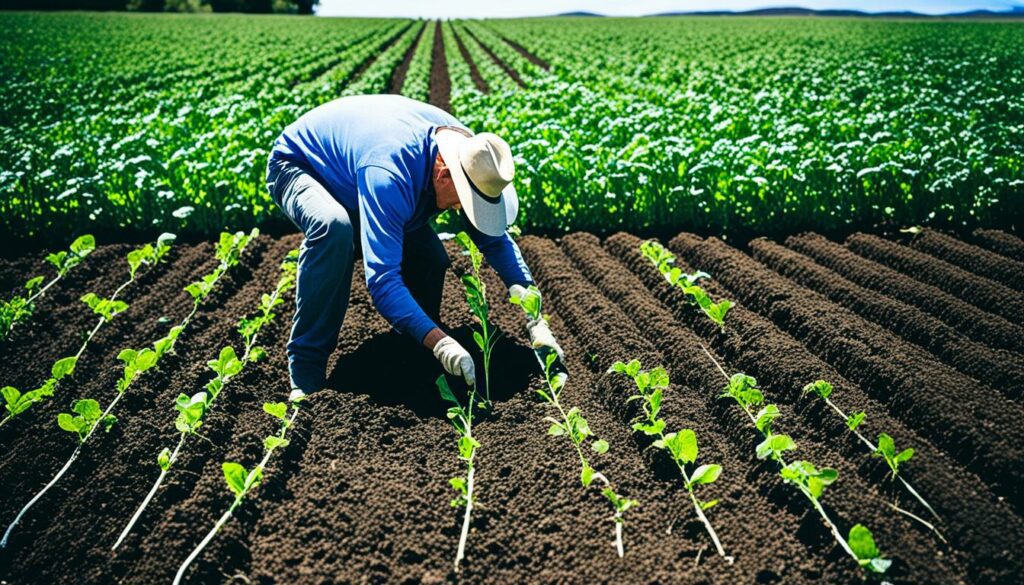
Managing farm waste right can reduce a lot of greenhouse gases. This includes using leftover farm products wisely. For example, livestock farming produces a lot of methane. By changing what the animals eat and using digesters, farms can lower these harmful emissions. For more details, check out this report.
Turning biomass into biogas is a smart move. With anaerobic digesters, farmers can make organic waste produce energy. This reduces the need for fossil fuels. In the U.S., farming in 2007 had a big role in creating or removing greenhouse gases. By using biomass, farms help the environment and gain a new energy source.
There are also government policies that push for biofuel and renewable energy. Laws like the Renewable Fuel Standard and the Portfolio Standards encourage farms to go greener. This helps the planet by using less oil and gas which is good for everyone.
Other helpful steps for farms are conservation tillage and no-till farming. These methods reduce greenhouse gases. Also, farms can get paid for using eco-friendly techniques. This is good for both their wallet and the Earth.
By using these sustainable farming methods, little farms can have a big impact on the world’s fight against climate change.
Small farms have a great chance to use NRCS technical services. These services offer many tools and support. They help farmers create strong conservation plans that match their needs. This promotes farming that is good for the land. Farm operators can get reliable advice. This helps them meet environmental rules without stress.
NRCS fact sheets are a treasure trove of info on eco-friendly farming. They make it easy to understand tough topics. So farmers can use efficient methods. The sheets talk about ways to boost soil and save water. They give real tips that help farms run better.
NRCS goes further than just handing out papers. They connect farmers with experts. These pros give one-on-one help. They help design and start plans to fix farm issues. Using NRCS tech services can really boost a farm’s green efforts. It means running a farm can make money and protect the earth.
Using good animal waste management systems offers lots of pluses for small farms. They deal with worries about the environment. Also, they help farms to keep going well and making more food. These systems cut down on harmful gases, make the soil better, and back ‘green’ farming ways.
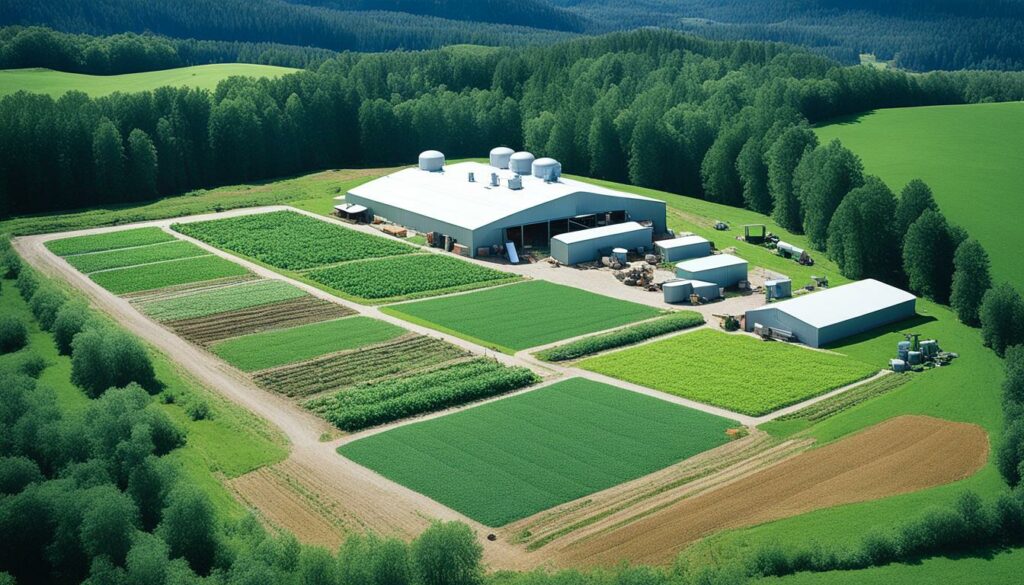
Getting rid of dead animals properly is key in animal waste management systems. The right ways prevent the earth from getting dirty and follow the rules. Ways like composting, rendering, and burning are good for the environment. They make sure the land stays healthy around the farm.
Looking after the nutrient management is crucial too. Manure is great for the soil. When used well, it makes plants grow better and keeps the soil in top form. A single horse can make a lot of manure in a year. But, when we manage it well, it feeds the soil with important stuff.
| Type of Animal | Daily Manure Production | Annual Manure Production |
|---|---|---|
| Chicken | 0.26 pounds | 4,700 pounds (2.37 tons) |
| Horse (1,100 pounds) | 50 pounds | 9 tons |
Doing the right things like testing the soil and using manure smartly helps a lot. This way, less good stuff washes away, and the land stays better. These steps are all about caring for the earth and following the law.
Soil erosion is a major threat to farm productivity and the environment. It is crucial to control erosion for sustainable farming. Thankfully, there are many ways for farmers to lessen erosion’s impact on their land.
Cover crops are key in preventing soil erosion. They protect the soil and have many other benefits too. Cover crops improve soil health, keep moisture in the ground, and stop weeds. This keeps the land healthy, productive, and reduces the risk of erosion, all in a sustainable way.
Grade stabilisation is also crucial for stopping erosion. These structures help keep the ground stable and save important soil nutrients. They lower nutrient loss and improve the land’s ability to hold onto soil. These methods are vital for a thriving agricultural environment that’s beneficial for both the land and its caretakers.
Using less energy on farms is key to saving money and helping the planet. Small farms can save a lot and lower their carbon footprint by using solar panels or wind turbines.
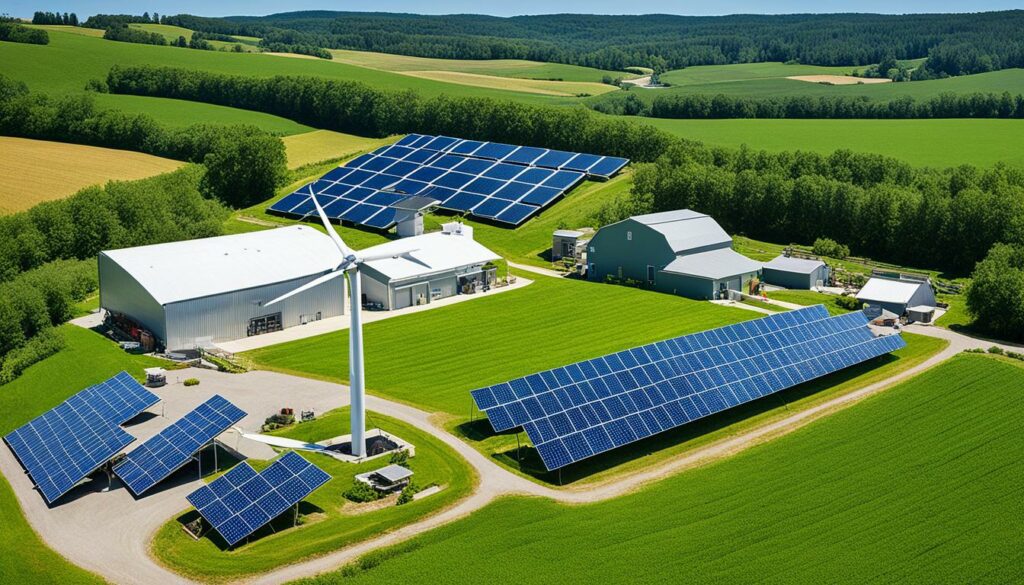
Solar panels are great for cutting down on electricity bills. LEDs are another good choice because they use much less electricity and last a long time. Making biogas from farm waste is also a smart, green move. It helps the environment and boosts local economies.
Setting up special areas can stop fires and keep farms safe. These barriers protect crops and places where animals graze. Less ploughing means the soil stays healthier. It can even make the soil capture more carbon, which is good for the planet.
| Practice | Benefit | Statistics |
|---|---|---|
| Solar Panels | Reduce electricity costs and carbon footprint | 75% less electricity with LEDs |
| Biogas Generation | Converts farm waste into renewable energy | Reduces reliance on non-renewable energy sources |
| Fuel and Fire Breaks | Protects crops and pastures | Enhances soil health with SOC increase of 1.7% to 3.6% |
Using less energy and renewable sources is more than saving money. It’s about making farms better for the future. It leads to a thriving environment and an eco-friendly future for small farms.
Today, following rules to protect the environment is very important for small farms. These farms usually depend on the work of family and friends. The new standards help these farms do their part for the planet, run their farms well, and follow all the important rules.
New rules focus on looking after the world around us and keeping good records. Since small farms can’t pay for their own checks, they work together. This makes keeping track of their work online easier.
The Rainforest Alliance sets specific goals for farms to meet. They have to check how much they grow each year using reliable ways. Using “Smart Meters” to farm better is also a must. Each farm has to share its location and do checks online.
To follow all these rules, farms need to spend money on training, people to help, tools, and checks. But the goal is to help farms earn more money, look after the people living there, and be fair in the big farming world. Special money helps in these efforts.
Did you know small farms are helping to fight climate change? They soak up carbon dioxide, helping our air stay clean. They use ways of farming that are good for the land, like growing different plants together. Even though small, they can be more productive than big, single-crop farms.
It’s hard work running a small farm, facing big challenges. In recent years, many farmers have sadly taken their own lives because of these pressures. Now, they earn very little from what you pay at the store, but they still choose to take care of the lands they use much better than larger farms do.
So, making sure small farms look after the environment isn’t just about meeting rules. It’s about helping all of us have a better, greener future. By doing their bit, small farms keep nature safe and keep growing good food.
This section looks at how financial help can aid small farms. It’s about helping them switch to green and sustainable ways. Financial support is key to making this happen. It lets farmers use new tech and methods that are good for the earth.
USDA microloans are a chance for small farms to get help. They need money to go green. These loans are easy to get and have terms that suit small farms. Money can go towards equipment, real estate, or even debt. The easy process and low needs to get a USDA microloan make it a good choice for small farmers who want to boost their eco-friendliness.
Crop insurance plays a big part in helping small farms too. It shields them from losing everything to bad weather or natural disasters. With this safety net, farms can stay green and keep going. It lets farmers invest in ways to farm better for the environment. Different insurance plans help different crops and areas, making sure everyone has a chance to keep farming.
| Program | Description | Benefits |
|---|---|---|
| USDA Microloans | Small loans for the needs of small farm operations. They cover buying equipment or land. | They offer easy money with flexible uses. This helps many farming needs. |
| Crop Insurance Options | Special insurance against losses from weather or disasters. | It cuts down the financial hit from losing crops. This supports green farming. |
To sum up, financial help like USDA microloans and crop insurance is vital for small farms. It gives them a boost to go green. These programs make sure farms stick to eco rules and can still make money.
Small farms play a huge part in sustainable agriculture and taking care of our environment. Even though small family farms cover almost half of US farmlands, they only make up five percent of the income. They find it hard to make money and market their products well, even though they are the majority.
To keep up with high environmental standards and make more money, small farms must use eco-friendly methods. In the Midwest, techniques like precision farming have upped their productivity. But not all farms can use these methods, so they need personal solutions.
Around the world, small farmers are hit by climate change, changing rain levels, and high costs. In poorer countries, farming is essential, but land is scarce. These farmers are tackling these problems with different crops, new jobs, and careful use of natural resources.
To meet the new environmental rules, all farmers must farm in a sustainable way. Small farms can get help from funding and better farming advice. This is a tough but doable goal, showing how important small farms are in the big picture of farming.
Small farms can use green techniques to stay sustainable. These include eco-friendly ways of farming and getting certified as organic. They should also protect different types of plants and animals.
NRCS gives advice on planning that fits each farm’s needs. They help to keep the environment safe and make sure the farm makes money. Techniques like planting cover crops and managing waste are used.
Composting manure improves the soil with good things for plants. It helps the farm work well with nature and increases how much is grown. This is a key part of being certified as organic.
Windbreaks and grassed waterways protect the land. Windbreaks stop strong winds harming crops. Grassed waterways help stop the land from washing away. They also provide homes for animals.
Small farms can use simple ways to water their crops. This can include using gravity or finding new water sources like springs. It’s very important for places that don’t have much water.
Organic certification shows the farm is good for the Earth. It helps the farm sell at better prices. This helps the farm and the environment stay strong.
Testing and rotating crops keep the soil well. These things stop the soil from getting weak and losing good things for plants. They also help more plants and animals to live there.
Making places for bees and birds is good for the farm. It makes sure crops are well-pollinated. It also helps the farm protect itself from bad insects. All this makes the farm greener.
Using waste in good ways helps the farm and the planet. It makes the soil better and stops harm to nature. It also makes energy without hurting the Earth.
NRCS shows how to farm in ways that are safe for the Earth. They give tips and connect farms with experts. This helps farms do well and follow important rules.
Keeping animal waste under control helps the farm and the environment. It makes the soil richer and the farm more sustainable. This is good for the farm’s future.
Smart use of cover crops and keeping the land even help stop the soil from washing away. These methods keep the soil strong and full of good things for plants. They are also good for the whole farm.
Using sources of energy that don’t run out, like the sun and wind, saves money and is good for the planet. Farms can also use less fuel and keep fires from spreading to save energy.
Programs by the USDA help small farms start or grow in a good way. They give money and help farms deal with risks. This makes sure farms stay strong and protect the environment.